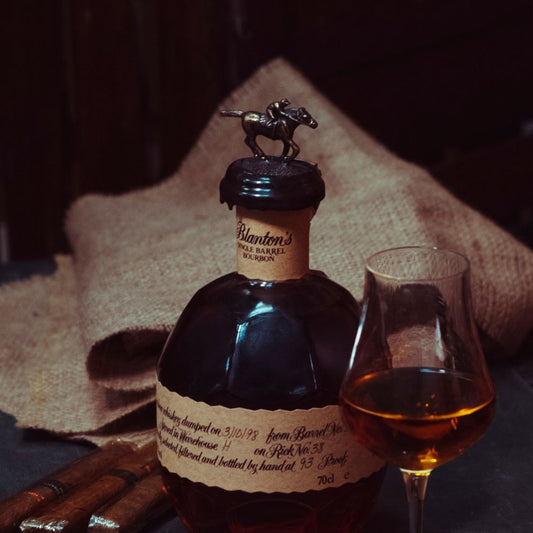What is Whiskey Made Of?

Whiskey, a beloved spirit savored worldwide, has a fascinating and multifaceted production process. This in-depth exploration will delve into the heart of whiskey, unveiling the key ingredients and detailed steps that transform simple grains into a flavorful elixir.
Whiskey Basics
Whiskey, an amber-hued liquor, offers an array of flavors and aromas, and is renowned for its versatility and depth. Predominantly made from cereal grains, it's a distilled alcoholic beverage appreciated by connoisseurs and casual drinkers alike. The essence of whiskey lies in its three primary ingredients: water, yeast, and grain.
However, the grandeur of whiskey extends beyond these fundamental components, encompassing time, wood, and the art of distillation.
The Primary Ingredients: Water, Yeast, and Grain
At the core of whiskey production are the three pillars: water, yeast, and grain.
Water: The Lifeblood of Whiskey
Water is integral to the whiskey-making process, utilized at multiple stages from mashing to dilution. It's the primary ingredient, used to cook the grains and convert their starches into fermentable sugars, later aiding in the distillation and maturation stages. While the impact of water on the final taste of whiskey is often debated, it undeniably remains a fundamental element in the whiskey's creation.
Yeast: The Magical Microorganism
Yeast, the silent hero in the whiskey production, instigates the fermentation process. This microscopic organism consumes the sugars in the mash, converting them into alcohol and carbon dioxide. Yeast also introduces distinct flavor profiles to the whiskey, with different strains leading to unique taste variations.
Grain: The Flavor Foundation
The flavor foundation of whiskey lies in its grain composition. The choice of grain, whether barley, corn, rye, or wheat, can significantly influence the whiskey's taste and character. The grain blend, also known as the 'mash bill,' dictates the category of whiskey being produced, with each type having specific requirements.
The Art of Distillation
Distillation, the heart of the whiskey-making process, refines the fermented grain mash into a potent spirit. The fermented mash, often referred to as the 'wash' or 'distiller's beer,' is heated in a still. The alcohol, having a lower boiling point than water, vaporizes first, rising through the still's neck, where it cools and recondenses into a liquid. The resulting high-proof spirit, known as the 'new-make' whiskey, is the birth of the whiskey we know and love.
The Significance of the Mash Bill
The mash bill, the specific combination of grains used in whiskey production, plays a crucial role in determining the whiskey's style and flavor. For instance, bourbon must be made from a mash bill consisting of at least 51% corn, while rye whiskey requires a minimum of 51% rye. Single malt Scotch, on the other hand, is made entirely from malted barley.
Aging: The Test of Time
Whiskey's transformation from a clear, fiery liquid to a smooth, amber spirit is a product of aging. Maturation in wooden barrels, typically oak, imparts color, flavor, and complexity to the whiskey. The duration of aging, along with the type of barrel used, significantly influences the final product.
The Magic of Wood
Wood plays a pivotal role in whiskey's maturation. Barrels, the silent partners in whiskey production, contribute to the spirit's color and account for 60-80% of the flavor. The type of wood used for the barrel, often American or French Oak, alongside the charring or toasting level of the barrel's interior, have a profound impact on the whiskey's character.
The Whiskey Varieties: A World of Flavor
The world of whiskey boasts a plethora of varieties, each with its unique set of rules and flavor profiles. Some of the popular whiskey types include:
- Bourbon Whiskey: Predominantly made from corn, bourbon whiskey is an American classic known for its sweet and full-bodied flavor.
- Rye Whiskey: Characterized by a spicy flavor profile, rye whiskey can be produced anywhere globally, with the condition that it contains at least 51% rye.
- Irish Whiskey: Renowned for its smooth and light flavor, Irish whiskey predominantly uses a blend of malted and unmalted barley.
- Scotch Whisky: Scotch whisky, distinctive for its smoky and robust flavor, is made primarily from malted barley and aged for a minimum of three years.
- Japanese Whisky: Similar to Scotch in many ways, Japanese whisky is known for its meticulous production process and refined flavor profile.
The Final Product: Whiskey Bottling
After aging, the whiskey undergoes one final step before it's ready for consumption – bottling. At this stage, water may be added to dilute the whiskey to its desired proof. However, 'cask strength' or 'barrel-proof' whiskeys bypass this step, offering a pure, undiluted tasting experience.
The Key Takeaways
Whiskey, a beverage steeped in tradition and craftsmanship, is much more than a distilled spirit. It's a labor of love, a testament to patience, and a celebration of nature's simple ingredients – grain, water, and yeast. The journey from field to bottle is intricate and fascinating, culminating in a drink that is enjoyed and cherished worldwide. Whether you're a seasoned connoisseur or a curious novice, the world of whiskey is a realm of endless discovery and sensory delight.
Sources:
Get recipes & ideas delivered to your inbox
Sign up for our newsletter to learn about releases, exclusive deals and more!
Recent Articles
- 12 Best Whiskies for an Old Fashioned
- 30 Popular Bourbons You Can Find Almost Anywhere
- What is Whiskey Made Of?
- The Science of Smoke: How Smoking Enhances Your Cocktails
- How to Pair the Right Wood Chips Your Smoked Cocktail
- How to Create a Home Bar Setup
- 10 Best Whiskeys to Stock Your Home Bar or Cart With
- Essential Bar Tools for Smoking a Cocktail
- What Are Good Smoked Cocktail Garnishes?
- Rye Whiskey vs Bourbon: What Are the Main Differences?



